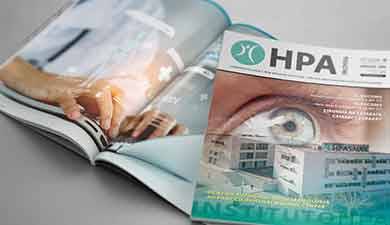Dr. Luís Almeida Dores
Otorhinolaryngologist

Ultrasonic rhinoplasty
The future of rhinoplasty at HPA
HPA Magazine 20
Rhinoplasty is a surgical procedure aimed at altering the nasal aesthetics and is currently one of the most sought-after surgeries in the field of otorhinolaryngology.
In addition to assessing nasal aesthetics, the surgeon evaluates and addresses functional changes in the nose, which means that during the same surgical procedure, nasal breathing is addressed through procedures such as septoplasty (correction of the nasal septum), turbinate surgery (correction of nasal turbinates), and even endoscopic sinus surgery (correction of chronic sinusitis).

Modern rhinoplasty should always be performed by a surgeon dedicated to nasal surgery as a whole, combining both form (aesthetics) and function (breathing) within the same surgical procedure.
The main nasal defects that lead patients to undergo rhinoplasty are a drooping or bulbous nasal tip, a high nasal dorsum (hump), and a deviated nose. One crucial component of aesthetic nasal surgery is the removal and reshaping of the nasal bone. In conventional techniques, a coarse rasp, hammer, and chisel were used for this purpose. This allowed for altering the bony structure to achieve the desired outcome. However, this technique was associated with increased post-operative swelling, hematoma, pain, and less intraoperative control.
In the search for improvements in these aspects, ultrasonic rhinoplasty was developed.
Ultrasonic rhinoplasty (Piezo) involves the use of a delicate electronic device based on ultrasonic wave production, allowing for precise cutting and shaping of compact structures like bone.
This technique enables millimeter-scale cutting and shaping of the nasal bone with less overheating and damage to adjacent structures.
As a result, effective and predictable surgical outcomes are achieved, with improved healing, reduced swelling, hematoma, pain, and post-operative complications. Notably, this technique can provide a virtually painless recovery period.
However, a frequent residual complaint is the occurrence of some nasal congestion in patients who require septal surgery, as a silicone plate is placed intranasally in such cases to maintain the septum alignment. It's worth noting that no nasal packing is used.
In terms of medication, the patient will undergo a seven-day cycle of oral antibiotics, and a healing ointment may be prescribed for the nasal incision area if applicable.
During the immediate post-operative period, minimal care is required: avoiding physical exertion and sleeping with an elevated headrest in the first week, and avoiding prolonged sun exposure in the first three months (generally, the use of a sunscreen with a factor equal to or greater than 50 is recommended during the first year after rhinoplasty).
At the end of the first week, a post-operative consultation is scheduled, during which the molded splint placed on the nasal dorsum is removed, any stitches are taken out (if present), and the nasal silicone plate is removed (in patients who underwent septal surgery). After this week, the patient can return to their normal activities without limitations.
Currently, all of our rhinoplasties are performed using ultrasonic techniques. We believe that Piezo technology is not just the future, but the present of rhinoplasty since it is already an integral part of our daily practice, with dozens of cases utilizing this technology. During the preoperative consultation, various cases of patients who have undergone this technique are shown, and through computer simulation, it is possible to discuss and decide on the desired final outcome.








